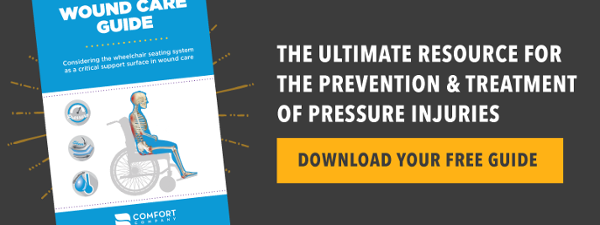As a therapist I am used to having tools to measure or evaluate my patients’ physical status and environmental conditions. These tools give me a baseline and paint a picture of a patients overall condition. When it comes to seating, there are so many factors in play when coming up with an appropriate system. It can be difficult to know during an evaluation if a wheelchair cushion/back will meet the goals of the patient when they leave the clinic. The more tools you have access to, the better the result will be for your patient. This is why a pressure map can be so useful.
Pressure Mapping provides information that a patient can’t often provide regarding the pressure redistribution of their seating surface when seated in their current chair. A pressure map is simply a pad with sensors that is placed on a wheelchair cushion. The patient transfers onto the pad and cushion and the system will provide either a snapshot or a live feed of the pressures under the seated surface. Systems are typically color coded with light blue being the least pressure to red being the most pressure. So when is it appropriate to use one?
Here are four reasons why you would definitely want to use a pressure map:
1) Persistent pressure injury
In this case the therapist has provided education on pressure relief, and the patient is seated on a skin protection cushion. The map is used to determine the source of the problem. The therapist can check the pressure areas when the back angle/support is altered or when the lower extremities are repositioned. Attempts can be made to modify the cushion or alternate cushions can be tried to see if they map differently. Getting to the cause of a persistent pressure injury can be a challenge, and a pressure map can facilitate getting to a result much faster.
2) Bio Feedback
A pressure map is an excellent tool to show patients how effective their pressure relieving techniques are in allowing blood flow to problem areas. A patient can be taught pressure relieving strategies such as leaning forward onto their knees, or leaning to one side and holding it, lifting their buttocks off the seat, or using tilt to completely offload the bony areas. The patient can be watching the screen and see how far they need to lean, lift, or tilt to get the desired result. This ensures their pressure relief attempts are effective.
3) Poor tissue integrity
Sometimes during an evaluation you will notice that a patient has a diagnosis that results in decreased tissue integrity. For example, a recent surgical procedure, an old spinal cord injury. In this case, it’s a good idea to map the patient and determine if there are higher pressure areas that are at risk for breakdown.
4) Poor Sensation
When a patient has little or no sensation, they are at risk for skin breakdown since they don’t have the sensory cue of pain or discomfort to provide warning. In this case, it is very useful to use a pressure map to identify an appropriate skin protection cushion and identify potential areas of breakdown. Then the patient can be trained in effective pressure relieving techniques as mentioned above.
Having access to a pressure map is invaluable when you are involved in seating evaluations or fittings. Achieving the best outcome for the patient is always the goal. A pressure map can be the tool that provides the information you need to meet the goal and finish well.

Stacey Mullis, OTR/ATP
Director of Clinical Marketing
Stacey is Director of Clinical Marketing. She graduated from Western University in London, Ontario, Canada with a BA Linguistics and BSc Occupational Therapy and has practiced as an OTR for over 20 years. With experience in pediatrics, inpatient/outpatient rehabilitation, long term care, and home health, Stacey has faced the challenges first hand of providing appropriate seating in various clinical settings. This led her to pursue an apprenticeship at Care Partners Seating Clinic in Asheville, NC to advance her skills, and she obtained her ATP certification in 2012. Mullis is a member of the NCOTA, CTF, NRRTs, RESNA, and AOTA.

